A lot of people build fictional helicopters out of LEGO. Many of them are really nice, but browsing flickr and being a member of the flickr military group, I've also seen lots that in my opinion could be a lot more realistic if the builders had a somewhat better understanding of how real-world helicopters work.
I wrote a somewhat rambling post about this on flickr about a year ago, but this time around I'll illustrate the points I was trying to make with pictures of LEGO helicopter models, both of fictional and of real-world helicopters. Here are a few examples of helicopters that prompted my post.
I am not singling out particular builders because I want to be nasty to them. I could have chosen a whole range of other pictures from flickr. The reason why I chose these is not because they are bad models, because they are not. They have a lot going for them: the builders have used nice techniques and have spent a lot of time fiddling with the details. The Wyvern even was the 2nd prize winner in the 'stealth' category of this year's build contest. However, each and every one of these models has a number of features that makes them look decidedly odd to me and as such serve to illustrate my point. Once you've read this post, my suggestion is to take another look at these. Hopefully you'll see what I mean.
I'll give you a sample of the sort of things I'll be focusing on, using a picture of my own OH-58D Kiowa Warrior as an example.
 It is not a fictional helicopter, unlike the ones I've shown so far, but it shows a number of features of a real helicopter.
It is not a fictional helicopter, unlike the ones I've shown so far, but it shows a number of features of a real helicopter. - Configuration: like most helicopters it has a single main rotor. This means that it needs a tail rotor
- Details: the Kiowa is covered with a lot of lumps and bumps, but it has many relatively smooth surfaces too and the overall shape is aerodynamic
- Engines: the Kiowa is powered by a single gas-turbine engine, with an air intake in the front and an exhaust on top
- Proportions: the tail rotor sits at the end of a fairly long tail boom. The tail boom is almost half the length of the overall length of the fuselage
I'll show more examples as I address each of these points in more detail.
Helicopter configurations
Most helicopters have a single rotor. In the picture below I've drawn a top view of a typical helicopter. In my drawing the rotor blades turn in a clockwise direction.

One or more engines turn the rotor blades relative to the fuselage. Physics (specifically conservation of angular momentum) tells you that the torque required to rotate the blades must be balanced. If it isn't, the fuselage of the helicopter would start to rotate in the opposite direction (counter-clockwise in my drawing). This is the reason why most single-rotor helicopters have a tail rotor. It generates a sideways force on the tail of the helicopter that balances the torque, keeping the tail pointing in the same direction. In my drawing this force points to the left. The internet is full of videos of helicopters crashing due to tail rotor failure, such as this one of a Sea King crashing aboard a US Navy Destroyer in 2002.
As far as I know, everybody aboard survived, but it wasn't pretty. Show me a single-rotor helicopter without a tail rotor and this is the sort of image that pops into my mind.
Some real-world helicopters have a system called NOTAR in which the sideways force is generated by blowing air through a specially shaped tailboom. Other helicopters use a so-called Fenestron (or fan tail), which is basically a tail rotor built into a duct in the tail. A nice example of a LEGO helicopter with a Fenestron is Aleksander Stein's SH-78.

There are a few alternative arrangements that involve one set of rotors turning in clockwise direction and a second set of rotors turning counter-clockwise.
- Coaxial rotors (one on top of the other), once again illustrated by a fictional model by Aleksander Stein:
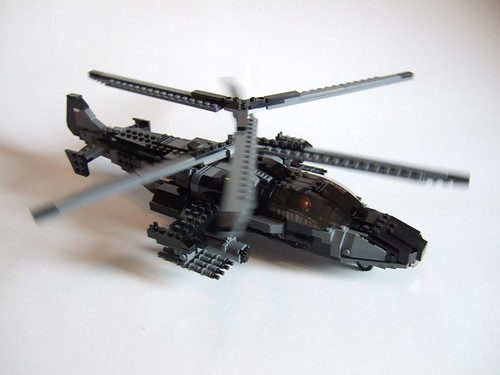
- Inter-meshing rotors, illustrated by Daniel Zayec's Fl-282 (the winner of the helicopter model category in the contest)
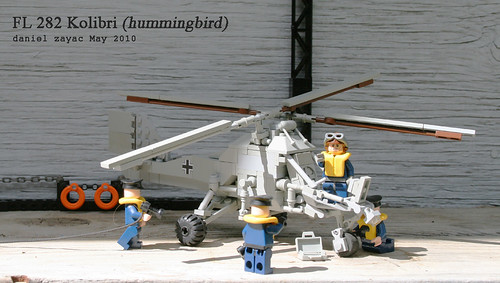 .
.
A fictional example was built by Dan Rubin.
- Tandem Rotors. An example of a model of a real-world helicopter with tandem rotors is my own CH-47D Chinook, with one set turning clock-wise and a another set turning counter-clockwise.
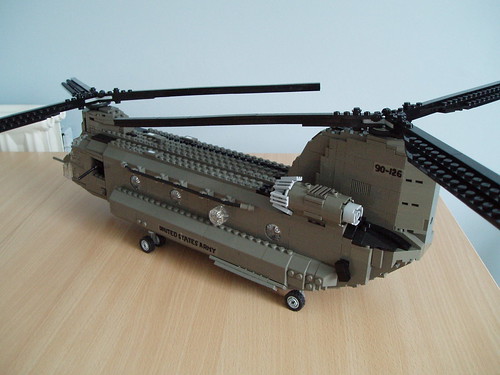
An alternative configuration, with the rotors side-by-side is Aleksander Stein's Fa-223 (the 2nd prize winner in the helicopter category of this year's competition).
The bottom line is that if you have a set of rotors turning, you'll need some way of countering the torque this generates. If you build a single-rotor helicopter, you'll need to think of a system to counter the torque. If you want to stick close to the real world, that means either a tail rotor, a Fenestron or a NOTAR system (which requires a specially shaped tail).
Details
The next item is more subjective than the previous one. Builders of space models generally prefer for their designs to have greebles or greebling. I have the impression that people who are very much into space building cannot resist adding greebles to machines where they are a bit inappropriate. While reducing drag isn't as important for helicopters as it is for aircraft, helicopters are supposed to move through air and some aerodynamic shaping makes sense. When building a helicopter you need to carefully balance your desire to add interesting details and the overall appearance of the helicopter as a vehicle designed to move through air. Beyond a certain point, adding more bits in an attempt to make things look interesting only makes them look messy. In that light, practice restraint when it comes to adding transparent bits representing lights in different colours, something I call random lights. Real helicopters don't have all that many lights and certainly none on the ends of the rotor blades!
Engines
Most modern helicopters are powered by gas turbine engines. These are essentially the same as a jet engine, but rather than delivering thrust directly they are used to rotate a shaft. It is connected to a gear box which drives the main and tail rotors. Gas turbines require a lot of air to run and produce a lot of hot exhaust gases. So, helicopters powered by gas turbines typically have an air intake and a big exhaust pipe. Many helicopters have more than one turbine, in which case they will usually also have more than one intake and exhaust. Magnus Lauglo's Pegasus is one example of a fictional helicopter which clearly shows the location of the gas turbine (above the passenger compartment) with an intake in front and exhaust at the back.
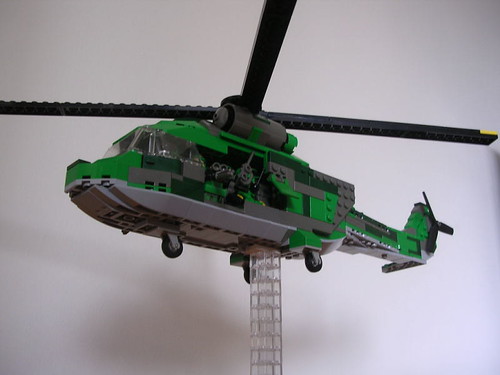 #
#As always, there are exceptions. Gas turbines are susceptible to damage from ingesting sand, so many helicopters have their intakes covered by particle filters. In that case, rather than a big round hole for the intake, there tends to be a cylindrical device sticking out with vents all around it, called a particle separator. It's clearly visible on the engine pod on my MH-53 model (shown here with its tail and rotor blades folded).

The picture of my Chinook clearly shows one of the helicopter's two engines mounted in a pod next to the aft rotor pylon. The exhaust pipe at the back is clearly visible, but the intake at the front is covered by vents; another example of a particle seperator.
To reduce the Infra-Red emissions of battlefield helicopters their exhausts are sometimes covered by large boxes that are designed to mix the hot exhaust gasses with cool ambient air. In that case, rather than a big pipe sticking out somewhere, there will usually be a big box with vents. The picture of Aleksander Stein's SH-78 shows such a box. Some light helicopters and old helicopters are powered by piston engines, which require less gas flow. they tend to have air intakes and exhausts that are far less visible on the outside. Examples are the Fa-223 and Fl-282 I've already shown. At the time when those were designed and flown, gas turbine engines were still in their infancy.
Proportions
This item is closely related to the section about the configuration. On a conventional, single rotor helicopter, the tail tends to be fairly long. The reason for this is quite simple. Since the strength of the torque generated by the tail rotor is a product of the distance to the centre of rotation of the helicopter and the sideways force generated by the tail rotor, the longer the tail is, the less force it needs to generate to counter the torque generated at the main rotor. Only helicopters with coaxial rotors or with inter-meshing rotors tend to have a short tail. The rotor is the main source of the lift that allows the helicopter to fly will sit close to the helicopter's centre of gravity. On a tandem helicopter, the centre of gravity will sit roughly in the middle between the two rotors. A consequence of this is that, typically, a single-rotor helicopter will have a tail boom that is about as long as the cabin (although it's not always easy to determine where the cabin ends and the tail begins) and the part of the fuselage behind the rotor mast is a lot longer than the part in front of it. Check out my Lynx, for instance:
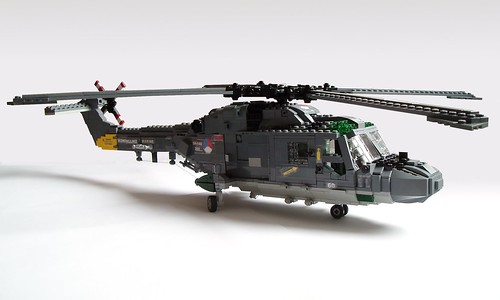
Anything else looks odd!
Putting it all together
You might be tempted to think that all these 'rules' are unnecessarily restrictive, but I am convinced that if you keep what I wrote in mind, the end result of building a helicopter will end up looking more convincing -irrespective of whether it is science fiction or supposed to be near-future/ contemporary military. Of course anybody who decides to build a helicopter is free to do this in whatever way he or she pleases. As usual with posts like this I am merely expressing my view, hoping that some of you may be able to use my advice to your advantage.
Building a fictional helicopter in some respects is a different game than building a model of a real helicopter. I normally do the latter and don't really have to think about where the rotor goes and where to put the exhaust; the real helicopter's designers have done all of that for me and I can simply stick to planning like I do for aircraft. However, having some sort of idea in mind of what your helicopter will look like before you start building might help you avoid some of the issues I described above.
I'll leave you with a picture of one of the few fictional helicopters that I myself built and which formed the basis for Aleksander Stein's SH-78, the HH-78 Gannet, both subject of an earlier post on this blog. I applied all of the things I discussed when building it, leading some people to question whether it is in fact a model of a real helicopter.

Happy building!


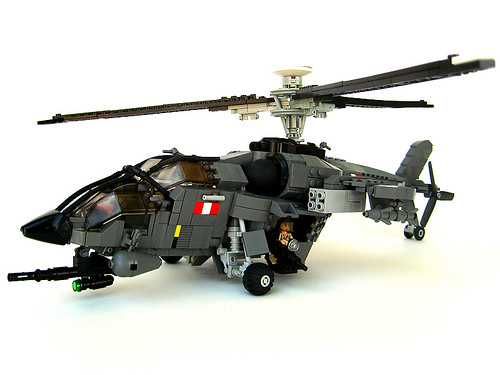

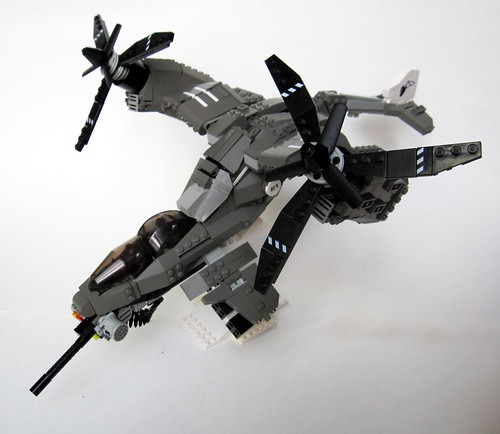
Wow, thanks! I plan on building a fictional heli soon and this will really help.
ReplyDeletegreat post ralph, but to be a little nitpicky, there are some helos with lights at the tips of the rotor blades (example: mil MI-8: http://www.bharat-rakshak.com/IAF/Images/Current/Helicopters/Mi8/Mi-17atnight.jpg.html). Other than that I agree with everything you've said. Again, nice article
ReplyDeleteThanks Mike. I learn something new everyday. It's certainly the first time I've ever seen them on anything other than an MV-22 Osprey. I don't think they're visible when the thing is sitting on the pad though and I wonder whether they are merely small reflectors/ chemical lights rather than electric.
ReplyDeleteOut of curiousity, what is it about mine that strikes you as odd? Tim Gould mentioned the off-center placement of the rotors, but is there something else that I've missed that makes the Wyvern decidedly unpractical?
ReplyDeleteFirst of all, it's a mean-looking thing and an impressive MOC. Please don't get me wrong on that.
ReplyDeleteHowever, I can't imagine a real design like it flying very well (if at all). The off-centre placement of the rotors is one issue. It simply doesn't look balanced. A second issue is the kink in the machine's spine, with the wings sitting far higher than the cockpit and the tail. I know it adds to the menacing look, but any aircraft/helicopter designer will try to make the frontal area of the vehicle small, in order to minimise drag. The tail is also completely blanked by the fuselage. (Dan Rubin's attack helicopter also suffers from this a bit).
I feel like I got kind of lucky with the Spatzenfalke. I didn't really pay specific attention to the details that real helicopters are supposed to have, and yet I feel like I do have quite a few.. (such as, a tail rotor to counter the main one, intakes for the engine, etc.)
ReplyDeleteHere's what I know to be wrong with it: There really aren't any exhaust ports to speak of, and the tail is far too short (I was running out of bricks, to be honest. I wanted it to be longer). Is there anything else?
I don't build helicopters often, but I'm sure I will get around to doing so again in the future, and I'd like it to be convincing.
Ralph,
ReplyDeleteThanks for another great and informative blog posting.
The debate/balance between realism/ functionality and "cool-factor" will always be an ongoing thing and up to the individual builder. But I think you do a good job of explaining helo basics, and choosing good illustrations.
Magnus
An update about the whole light thing:
ReplyDeleteI did some research and apparently most Russian helos have electric lights at the end of their blades. Apparently the pilots get a kick out of turning them on and off above cities.... makes for a lot of UFO reports.
in this picture you can just make it out on the tip of the blade:
http://www.helicopter-database.de/open.photo.php?idphoto=5389
@spook
ReplyDeleteThanks for not taking my comments badly. It is a nice MOC. I think you've summed up most of it. The tail looks short and the rotor seems to be placed relatively far aft.
@Magnus
Thanks. Obviously this is just my take, but as some of the fictional helicopters I put in the post show a high 'cool-factor' and realism fortunately aren't mutually exclusive.
@Mike
Thanks for that. Electric lights! I wonder whether that is because they're not quite as used to using NVGs.
brill
ReplyDeletei gonna try make one of those
love the humming bird
ReplyDeleteThe Co-Axial is a Ka-52....
ReplyDeleteI like the most military ones the best. I am planning on building one soon.
ReplyDeletemost of them i like
ReplyDeletePerhaps one is not always going for a realistic helicopter. I think that because Lego is a creative medium, can take artistic license with the design of a helicopter and take freedom with regard to realism.
ReplyDeleteI have been a 58 mechanic for the passed 19 years. I was wondering if you an instruction set made up for this? I have looked every where and this is by far the best Lego Kiowa I have seen.
ReplyDelete